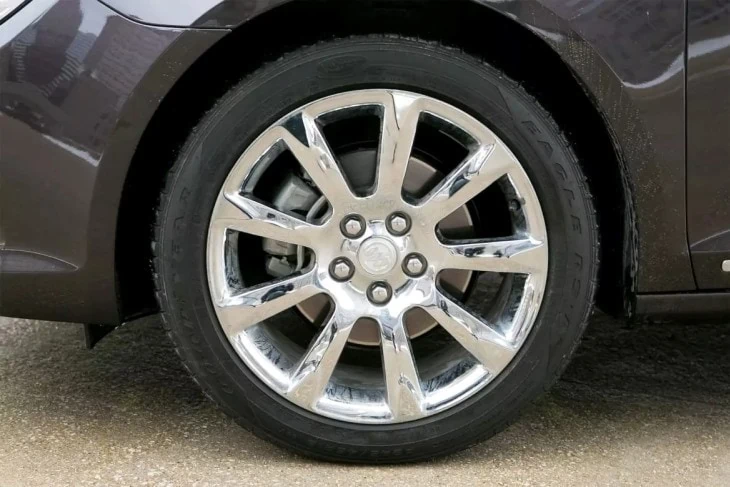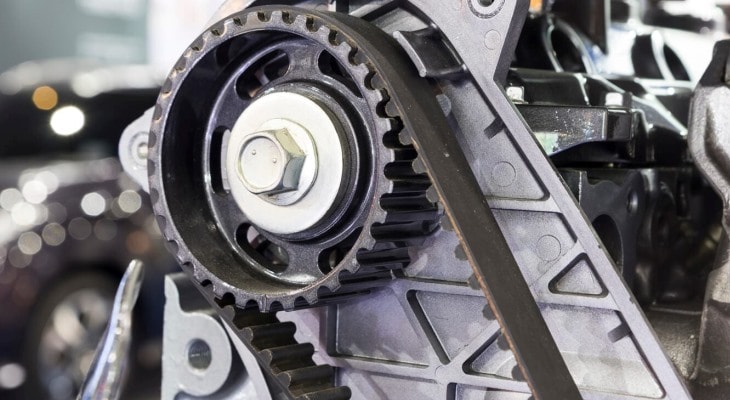Nothing is more aggravating than a squeaking noise coming from your car as you drive down the road.
It’s simply annoying and potentially embarrassing. Not to mention, it may make you wonder if there is a serious safety issue that needs attention.
Squeaking noises have a long list of places they can come from in your car. They may come from worn suspension components, bushings or bearings, or even different parts of the interior. It’s also possible for a loose belt or failing bearing under the hood to cause a squeaking sound.
Table of Contents
What Causes a Squeak?

Understanding why something could make a squeaking noise will help you find the problem, and know how to correct it. Squeaking occurs when two parts are rubbing together when they shouldn’t be.
To find the noise, pay attention to when and how it happens. Is it when going over bumps or rough pavement? Does it change with vehicle speed?
Maybe it happens randomly, or it changes with your engine speed. See if you can pinpoint the driving conditions that cause the noise. This will tell you where to look first.
Brakes
Brakes are by far the most common source of a squeak noise. Most of the time, it happens when you hit the brakes. Here are the main causes:
- Pad squealers are hitting the rotors – it’s time for new brake pads!
- Brake dust buildup/foreign material stuck in brakes – give your brakes a good cleaning with some brake cleaner.
- Lack of lubrication or shims – make sure all the factory hardware is installed and that all moving parts are properly lubricated
Wet or rusted rotors can also cause a squeak from the brakes, as can certain aftermarket brake pads.
Suspension
Bumps cause the suspension to flex. If your squeak noise happens when going over bumps or rough roads, this is the first place you should look.
When it comes to suspension, anything and everything can potentially cause a squeak noise. I’ll cover the most common culprits here.
It helps if you can have a friend rock the car from side to side, this can sometimes trigger the noise and make it easier to tell exactly where it’s coming from.
Worn Rubber Bushings

A suspension bushing is a piece of solid, flexible rubber. It’s designed to allow parts to move when they need to, but to keep it all quiet and provide a comfortable ride. When they wear out, the rubber can start to squeak when moved.
Some bushings are there only to keep parts from making contact. The rubber spring seats are a good example of this, they keep the springs from rubbing on their perches. When these wear out, it’s very likely you’ll have a squeak or other kind of noise.
The bushings in your control arms usually surround the bolts that hold the arms in place. Take a look at the bushings, a little cracking in the rubber is ok, but large tears are problematic. If there are large tears or the bushing has separated from the arm, it’s a likely source of the noise.
Very commonly the sway bar mounting bushings can cause a squeak. They may be totally worn out, but they can also just be dry. You’ll have to take them off to check for cracks, and you can try greasing them (with something like this) and reusing them if they look OK.
As I mentioned earlier, the spring seats can wear away over time and cause the spring to rub on the perch. The perch may be on the control arm, strut, or axle depending on your car. If the rubber seal at the bottom looks like it’s deteriorating, it should be replaced as it could be causing your squeak.
This isn’t a full list of every possible suspension bushing. Bushings can also be found at the mounting points for your struts/shocks, or as part of your subframe.
Special Considerations for Trucks
On trucks, in particular, there are usually more bushings. The body and bed are mounted to the frame with several large bushings called “body mounts”. With age, these are prone to wear and will start causing squeaks and other types of noises after they degrade past a certain point.
Many trucks use leaf springs over a solid rear axle. The same principles apply to the bushings here, but the springs themselves are prone to noise-making since they are stacked on top of each other. Any looseness or rust can become an issue, so make sure they are tight and use grease on them if necessary.
Shocks and Struts
This is less common but not unheard of. Shocks and struts can make a squeak noise when they start to wear out. It can be very difficult to determine for sure if a noise is coming from the strut, however.
The best way to be sure requires your friend to be shaking the car side to side as mentioned earlier. If this does trigger the noise, go around the car spraying some WD40 along the silver strut shafts.
If your noise suddenly stops when spraying one of them, you know you’ve found the culprit!
Under the Hood

Most of the things under the hood that cause a squeak will change in frequency with engine speed. This means if you rev the engine up, the squeak will occur faster. There is a lot to check here, too, so I’ll cover the most common items again.
A word of caution, please be careful under the hood of a running vehicle. Make sure it is in park (or with the parking brake on if it has a manual transmission) and keep your hands CLEAR of all moving parts.
The fans may be plastic but they can and will cut you badly if you get something caught in them.
Belts, Pulleys, and Fans
The leading cause for underhood squeaks is a loose or failing belt. First, make sure the belt is tight and the tensioner is working properly. Then, spray a little WD40 on the belt while it’s running – if the squeak goes away it’s likely a new belt will fix it.
Keep in mind there could be rust or imperfections on a pulley that are causing your squeak and these can stop when lubed as well. Make sure you inspect them all (with the engine off!) just in case.
If you do replace the belt, also check that all the pulleys spin freely by hand with no noise. The bearings inside can fail which may also cause a squeak. This goes for idlers, tensioners, the alternator, water pump, and AC compressor too.
Your fan has bearings that can go bad too. For mechanical fans, check them the same way you did with your other pulleys (engine off!). For electric fans, you’ll have to let the car warm up and wait for them to come on to see if they are making noise.
Internal Engine
In some cases, you can get a squeak from inside the engine itself. These squeaks can seem completely random but they will usually be in rhythm with the engine. They’ll have a slightly metallic sound to them as well.
Usually, this is due to low oil. Check the oil level and add to the “full” mark if necessary. If the noise does not go away there may be engine damage, and you should have it looked at by a professional.
Creaking Noises

Creaking noises can often be treated the same way as squeaking noises. All of the same suspension items should be checked. Generally, creaking won’t come from something under the hood.
There are certain items that are more likely to creak than squeak, mainly wheel bearings and drive joints. Checking these can be difficult, however.
If you’re hearing a creaking noise when driving at a low speed there’s a good chance you’ve got a failing CV axle or U joint in the driveshaft.
The noise will change with vehicle speed and may go away once you’re moving fast enough. Check for looseness or signs of wear in these joints, and replace them as necessary.
Wheel bearings are usually characterized as a groaning or grinding sound, but creaking is not unheard of. Failing wheel bearings generally will change volume when turning the wheel back and forth while driving. Without proper equipment, these can be very difficult to pinpoint, however.
In unusual cases, the brakes can also cause a creaking sound. Most times this will be a backing plate hitting the rotor, and it can be bent out of the way to give the rotor enough clearance. Make sure you check all the other items I mentioned in the brake squeak section as well.
Interior Squeaks

Last but not the least, your noise may be coming from inside the car. It’s pretty easy to tell, as the noise will be much clearer and feel closer to you. Use the same technique as before to determine when and how the noise occurs to help you find the location.
It’s a good idea to remove all loose objects from inside the car. These can cause noises and make you think there’s an issue when there’s really not.
Once you’ve confirmed something is definitely wrong and located the source you can start making repair attempts. If some panels are rubbing together, try some felt tape like this between them to stop the noise.
Loose or dry seat adjusters can make noise too. Make sure all moving parts are greased and all bolts are tight. This goes for all your other interior panels and parts as well.
Final Notes
Remember, this is not an exhaustive list of potential squeak causes, but the basic idea of finding the noise will be the same no matter what. If you can duplicate it, you can listen to where it’s coming from and find the cause.
Once again, please be careful with all moving parts. Keep all loose clothing and tools away from belts and fans. Keep all this in mind and you’ll be well on your way to a noise-free ride!

